Molecular characteristics and laminar distribution of prefrontal neurons projecting to the mesolimbic system
- PMID: 36063145
- PMCID: PMC9444245
- DOI: 10.7554/eLife.78813
Molecular characteristics and laminar distribution of prefrontal neurons projecting to the mesolimbic system
Abstract
Prefrontal cortical influence over the mesolimbic system - including the nucleus accumbens (NAc) and the ventral tegmental area (VTA) - is implicated in various cognitive processes and behavioral malfunctions. The functional versatility of this system could be explained by an underlying anatomical complexity; however, the detailed characterization of the medial prefrontal cortical (mPFC) innervation of the NAc and VTA is still lacking. Therefore, combining classical retrograde and conditional viral tracing techniques with multiple fluorescent immunohistochemistry, we sought to deliver a precise, cell- and layer-specific anatomical description of the cortico-mesolimbic pathways in mice. We demonstrated that NAc- (mPFCNAc) and VTA-projecting mPFC (mPFCVTA) populations show different laminar distribution (layers 2/3-5a and 5b-6, respectively) and express different molecular markers. Specifically, calbindin and Ntsr1 are specific to mPFCNAc neurons, while mPFCVTA neurons express high levels of Ctip2 and FoxP2, indicating that these populations are mostly separated at the cellular level. We directly tested this with double retrograde tracing and Canine adenovirus type 2-mediated viral labeling and found that there is indeed minimal overlap between the two populations. Furthermore, whole-brain analysis revealed that the projection pattern of these populations is also different throughout the brain. Taken together, we demonstrated that the NAc and the VTA are innervated by two, mostly nonoverlapping mPFC populations with different laminar distribution and molecular profile. These results can contribute to the advancement in our understanding of mesocorticolimbic functions and its disorders in future studies.
Keywords: cortical organization; laminar topography; mouse; neuroscience; nucleus accumbens; prefrontal cortex; pyramidal cell types; ventral tegmental area.
© 2022, Babiczky and Matyas.
Conflict of interest statement
ÁB, FM No competing interests declared
Figures


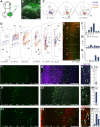
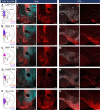

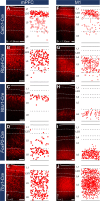

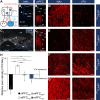
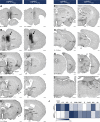

Update of
- doi: 10.1101/2022.02.17.480862
Similar articles
-
Expression of 5-HT2A receptors in prefrontal cortex pyramidal neurons projecting to nucleus accumbens. Potential relevance for atypical antipsychotic action.Neuropharmacology. 2014 Apr;79:49-58. doi: 10.1016/j.neuropharm.2013.10.021. Epub 2013 Nov 7. Neuropharmacology. 2014. PMID: 24211653
-
Role of dopamine projections from ventral tegmental area to nucleus accumbens and medial prefrontal cortex in reinforcement behaviors assessed using optogenetic manipulation.Metab Brain Dis. 2017 Oct;32(5):1491-1502. doi: 10.1007/s11011-017-0023-3. Epub 2017 May 19. Metab Brain Dis. 2017. PMID: 28523568
-
Brain-derived neurotrophic factor-mediated projection-specific regulation of depressive-like and nociceptive behaviors in the mesolimbic reward circuitry.Pain. 2018 Jan;159(1):175. doi: 10.1097/j.pain.0000000000001083. Pain. 2018. PMID: 29076919 Free PMC article.
-
The heterogeneity of ventral tegmental area neurons: Projection functions in a mood-related context.Neuroscience. 2014 Dec 12;282:101-8. doi: 10.1016/j.neuroscience.2014.06.006. Epub 2014 Jun 12. Neuroscience. 2014. PMID: 24931766 Free PMC article. Review.
-
Functional relationship among medial prefrontal cortex, nucleus accumbens, and ventral tegmental area in locomotion and reward.Crit Rev Neurobiol. 2000;14(2):131-42. Crit Rev Neurobiol. 2000. PMID: 11513242 Review.
Cited by
-
The PFC-LH-VTA pathway contributes to social deficits in IRSp53-mutant mice.Mol Psychiatry. 2023 Nov;28(11):4642-4654. doi: 10.1038/s41380-023-02257-y. Epub 2023 Sep 20. Mol Psychiatry. 2023. PMID: 37730842 Free PMC article.
-
Drug-induced change in transmitter identity is a shared mechanism generating cognitive deficits.Res Sq [Preprint]. 2023 Dec 13:rs.3.rs-3689243. doi: 10.21203/rs.3.rs-3689243/v1. Res Sq. 2023. Update in: Nat Commun. 2024 Sep 26;15(1):8260. doi: 10.1038/s41467-024-52451-x. PMID: 38168375 Free PMC article. Updated. Preprint.
-
Drug-induced change in transmitter identity is a shared mechanism generating cognitive deficits.Nat Commun. 2024 Sep 26;15(1):8260. doi: 10.1038/s41467-024-52451-x. Nat Commun. 2024. PMID: 39327428 Free PMC article.
-
FOXP2-immunoreactive corticothalamic neurons in neocortical layers 6a and 6b are tightly regulated by neuromodulatory systems.iScience. 2024 Dec 19;28(1):111646. doi: 10.1016/j.isci.2024.111646. eCollection 2025 Jan 17. iScience. 2024. PMID: 39868047 Free PMC article.
-
Self-supervised deep clustering of single-cell RNA-seq data to hierarchically detect rare cell populations.Brief Bioinform. 2023 Sep 22;24(6):bbad335. doi: 10.1093/bib/bbad335. Brief Bioinform. 2023. PMID: 37769630 Free PMC article.
References
-
- Akhter F, Haque T, Sato F, Kato T, Ohara H, Fujio T, Tsutsumi K, Uchino K, Sessle BJ, Yoshida A. Projections from the dorsal peduncular cortex to the trigeminal subnucleus caudalis (medullary dorsal horn) and other lower brainstem areas in rats. Neuroscience. 2014;266:23–37. doi: 10.1016/j.neuroscience.2014.01.046. - DOI - PubMed
Publication types
MeSH terms
LinkOut - more resources
Full Text Sources
Molecular Biology Databases

